6f7e6cdacf2732de37b8422b8b041b0a.ppt
- Количество слайдов: 130
 How we learn versus how we think we learn: Implications for the design and evaluation of instruction Robert A. Bjork University of California, Los Angeles Carl Wieman Science Education Initiative University of British Columbia Vancouver, Canada September 30, 2009
How we learn versus how we think we learn: Implications for the design and evaluation of instruction Robert A. Bjork University of California, Los Angeles Carl Wieman Science Education Initiative University of British Columbia Vancouver, Canada September 30, 2009
 The problem: n Conditions of instruction that make performance improve rapidly often fail to support long-term retention and transfer, …whereas n Conditions of instruction that appear to create difficulties for the learner, slowing the rate of apparent learning, often optimize long-term retention and transfer
The problem: n Conditions of instruction that make performance improve rapidly often fail to support long-term retention and transfer, …whereas n Conditions of instruction that appear to create difficulties for the learner, slowing the rate of apparent learning, often optimize long-term retention and transfer
 Learning versus performance n Empirical evidence: n Old evidence: Learning without performance: n n “Latent learning” studies; Motor skills studies Newer evidence: Performance with little or no learning; The bottom line: n n n What we can observe is performance; What we must infer is learning; …and the former is an unreliable guide to the latter.
Learning versus performance n Empirical evidence: n Old evidence: Learning without performance: n n “Latent learning” studies; Motor skills studies Newer evidence: Performance with little or no learning; The bottom line: n n n What we can observe is performance; What we must infer is learning; …and the former is an unreliable guide to the latter.
 Corresponding conceptual distinctions: n Hull n n (1943): Momentary reaction potential versus Habit strength n Estes n n Response strength versus Habit strength n Bjork n n (1955): & Bjork (1992): Retrieval strength versus Storage strength
Corresponding conceptual distinctions: n Hull n n (1943): Momentary reaction potential versus Habit strength n Estes n n Response strength versus Habit strength n Bjork n n (1955): & Bjork (1992): Retrieval strength versus Storage strength
 The tendency to, and perils of, interpreting retrieval strength as storage strength n Retrieval strength is heavily influenced by recency and cues that are available now, but are unlikely be available later n Interpreting retrieval strength as storage strength (i. e. , learning) contributes greatly to our (and our teachers) over-estimating the degree to which learning has been achieved.
The tendency to, and perils of, interpreting retrieval strength as storage strength n Retrieval strength is heavily influenced by recency and cues that are available now, but are unlikely be available later n Interpreting retrieval strength as storage strength (i. e. , learning) contributes greatly to our (and our teachers) over-estimating the degree to which learning has been achieved.
 Examples of manipulations that introduce “desirable difficulties” (Bjork, 1994) for the learner n Varying the conditions of learning n Distributing or spacing study or practice sessions n Using tests (rather than presentations) as learning events n Providing “contextual interference” during learning (e. g. , interleaving rather than blocking practice)
Examples of manipulations that introduce “desirable difficulties” (Bjork, 1994) for the learner n Varying the conditions of learning n Distributing or spacing study or practice sessions n Using tests (rather than presentations) as learning events n Providing “contextual interference” during learning (e. g. , interleaving rather than blocking practice)
 The word desirable is important … n Many difficulties are undesirable during learning, after learning, and forever after n Desirable difficulties are desirable because responding to them (successfully) engages processes that support learning, comprehension, and remembering n They become undesirable difficulties if the learner is not equipped to respond to them successfully. n Generation effects as an example.
The word desirable is important … n Many difficulties are undesirable during learning, after learning, and forever after n Desirable difficulties are desirable because responding to them (successfully) engages processes that support learning, comprehension, and remembering n They become undesirable difficulties if the learner is not equipped to respond to them successfully. n Generation effects as an example.
 June 2009 message from Tim (“Oz”) Ozman (Chief, Ground Maintenance Branch; CASCOM Training Directorate; Fort Lee, Virginia) n “To provide an example of how I think I'm trying to achieve transfer -currently we teach a mechanic to trace an electrical schematic of a particular vehicle, practice on that vehicle, then test on that vehicle. My approach would be to train on the most complex schematic they will encounter, practice on totally different pieces of equipment, followed by testing on yet another item of equipment. The intent is to train them to interpret schematics, not just one specific schematic. My understanding from your writing is that performance on the test may suffer (near in time), but will increase remote in time (say, 6 months after graduating the course). Am I on the right track? ”
June 2009 message from Tim (“Oz”) Ozman (Chief, Ground Maintenance Branch; CASCOM Training Directorate; Fort Lee, Virginia) n “To provide an example of how I think I'm trying to achieve transfer -currently we teach a mechanic to trace an electrical schematic of a particular vehicle, practice on that vehicle, then test on that vehicle. My approach would be to train on the most complex schematic they will encounter, practice on totally different pieces of equipment, followed by testing on yet another item of equipment. The intent is to train them to interpret schematics, not just one specific schematic. My understanding from your writing is that performance on the test may suffer (near in time), but will increase remote in time (say, 6 months after graduating the course). Am I on the right track? ”
 Varying the conditions of learning (Example: Kerr & Booth, 1978) Design n Two age groups: 8 -year-olds & 12 -year-olds Task: beanbag toss to target on floor (occluded) Conditions of Practice: n Fixed: All practice at a fixed (criterion) distance; n Varied: Practice at criterion distance +/- one foot (never at the criterion distance)
Varying the conditions of learning (Example: Kerr & Booth, 1978) Design n Two age groups: 8 -year-olds & 12 -year-olds Task: beanbag toss to target on floor (occluded) Conditions of Practice: n Fixed: All practice at a fixed (criterion) distance; n Varied: Practice at criterion distance +/- one foot (never at the criterion distance)
 Kerr and Booth (1978): Results n Absolute Error (inches) on Final Test (3 -feet distance for 8 -year-olds) Age of Participant Practice Condition Fixed (criterion) Varied (criterion +/- 1 ft) 8 years 12 years 8. 31 5. 55
Kerr and Booth (1978): Results n Absolute Error (inches) on Final Test (3 -feet distance for 8 -year-olds) Age of Participant Practice Condition Fixed (criterion) Varied (criterion +/- 1 ft) 8 years 12 years 8. 31 5. 55
 Kerr and Booth (1978): Results n Absolute Error (inches) on Final Test (3 -feet distance for 8 -year-olds) Age of Participant Practice Condition 8 years 12 years Fixed (criterion) 8. 31 5. 55 Varied (criterion +/- 1 ft) 5. 42 4. 63
Kerr and Booth (1978): Results n Absolute Error (inches) on Final Test (3 -feet distance for 8 -year-olds) Age of Participant Practice Condition 8 years 12 years Fixed (criterion) 8. 31 5. 55 Varied (criterion +/- 1 ft) 5. 42 4. 63
 Varying the environmental context of learning (Smith, Glenberg, & Bjork, 1978) Tested in Room A Study in Room A Tested in Room B Study in Room A Tested Room C Study in Room B Tested Room C
Varying the environmental context of learning (Smith, Glenberg, & Bjork, 1978) Tested in Room A Study in Room A Tested in Room B Study in Room A Tested Room C Study in Room B Tested Room C
 Distributing/Spacing of Practice Baddeley & Longman (1979) 1 x 1 hr 34. 9 Training Schedule 2 x 1 hr 1 x 2 hr Hours to Learn Keyboard 42. 6 43. 2 2 x 2 hr 49. 7 Mean Satisfaction Rating 1 (Very Satisfactory) to 5 (Very Unsatisfactory) 2. 40 1. 86 2. 00 1. 73
Distributing/Spacing of Practice Baddeley & Longman (1979) 1 x 1 hr 34. 9 Training Schedule 2 x 1 hr 1 x 2 hr Hours to Learn Keyboard 42. 6 43. 2 2 x 2 hr 49. 7 Mean Satisfaction Rating 1 (Very Satisfactory) to 5 (Very Unsatisfactory) 2. 40 1. 86 2. 00 1. 73
 Tests versus presentations as learning events n Testing as pedagogy versus testing as assessment n Retrieving information or procedures is a learning event n n n The information/procedures recalled become more recallable in the future than they would have been otherwise; It is substantially more powerful event than is being presented the information (inflatable life vest example) Tests provide far better feedback as to what has or has not been learned/understood (vs. presentations) Tests potentiates the effectiveness of subsequent study Survey of illustrative findings
Tests versus presentations as learning events n Testing as pedagogy versus testing as assessment n Retrieving information or procedures is a learning event n n n The information/procedures recalled become more recallable in the future than they would have been otherwise; It is substantially more powerful event than is being presented the information (inflatable life vest example) Tests provide far better feedback as to what has or has not been learned/understood (vs. presentations) Tests potentiates the effectiveness of subsequent study Survey of illustrative findings
 The power of tests as learning events: Roediger and Karpicke (2006) n To-be-learned text passage on the sun or on sea otters (about 30 idea units per passage) n Three conditions n n n SSSS: four consecutive 5 -min study periods SSST: three study period plus a test of recall for the passage STTT: one study period plus four consecutive tests of recall for the passage
The power of tests as learning events: Roediger and Karpicke (2006) n To-be-learned text passage on the sun or on sea otters (about 30 idea units per passage) n Three conditions n n n SSSS: four consecutive 5 -min study periods SSST: three study period plus a test of recall for the passage STTT: one study period plus four consecutive tests of recall for the passage
 Roediger & Karpicke (2004) (Passage on the sun or on sea otters; about 30 idea units in each passage)
Roediger & Karpicke (2004) (Passage on the sun or on sea otters; about 30 idea units in each passage)
 Roediger & Karpicke (2004)
Roediger & Karpicke (2004)
 Roediger & Karpicke (2004)
Roediger & Karpicke (2004)
 Roediger & Karpicke (2004)
Roediger & Karpicke (2004)
 Using tests to self-regulate one’s learning: Kornell & Bjork (2008) n Using flashcards is a very common study technique— and one that, potentially, taps into both the memory and metamemory virtues of testing; n Dropping flashcards deemed to have been learned is common and, intuitively, a way to maximize the efficiency of study; n But is dropping a good thing?
Using tests to self-regulate one’s learning: Kornell & Bjork (2008) n Using flashcards is a very common study technique— and one that, potentially, taps into both the memory and metamemory virtues of testing; n Dropping flashcards deemed to have been learned is common and, intuitively, a way to maximize the efficiency of study; n But is dropping a good thing?
 Real life flashcard habits 40% 60% Do you study with flashcards in real life?
Real life flashcard habits 40% 60% Do you study with flashcards in real life?
 Real life flashcard habits 30% 40% 60% Do you study with flashcards in real life? 70% If so, do you remove cards from your stack as you go?
Real life flashcard habits 30% 40% 60% Do you study with flashcards in real life? 70% If so, do you remove cards from your stack as you go?
 Method: Kornell & Bjork (2008) n n Participants learned two lists of 20 English-Swahili word pairs via a computerized flashcard procedure Self-regulation conditions n n Dropping items permitted for one list; Not for the other list (order counterbalanced) (Important: Total study time fixed at 10 min per list) Delay before the final test n n Immediate 1 week
Method: Kornell & Bjork (2008) n n Participants learned two lists of 20 English-Swahili word pairs via a computerized flashcard procedure Self-regulation conditions n n Dropping items permitted for one list; Not for the other list (order counterbalanced) (Important: Total study time fixed at 10 min per list) Delay before the final test n n Immediate 1 week


 No-drop condition
No-drop condition
 Drop condition
Drop condition
 Final test (with answer filled in)
Final test (with answer filled in)
 Results Statistics: All > Selective, No interaction
Results Statistics: All > Selective, No interaction
 Why did being permitted to drop items actually impair learning? n Possible factors n n Spacing of trials on a given pair decreases as items are dropped; Participants’ metacognitive judgments are flawed n n n Dropping, to be effective, requires accurate judgments of learning; Subsequent experiments revealed that participants dropped items that would have profited greatly from even a single additional trial Remaining question: n n When items are dropped, is the cost to their later recall attributable to their not being studied again, not being tested again, or both? Karpicke and Roediger’s (2008) study
Why did being permitted to drop items actually impair learning? n Possible factors n n Spacing of trials on a given pair decreases as items are dropped; Participants’ metacognitive judgments are flawed n n n Dropping, to be effective, requires accurate judgments of learning; Subsequent experiments revealed that participants dropped items that would have profited greatly from even a single additional trial Remaining question: n n When items are dropped, is the cost to their later recall attributable to their not being studied again, not being tested again, or both? Karpicke and Roediger’s (2008) study
 The study/test method for learning vocabulary items and other materials n Alternating study and test cycles (through to-belearned list of items) n n n Study cycle: (…, Lesa: scarf, …) Test cycle: (…, Lesa: __? __, …) … Standard assumption: Study cycles provide opportunities for learning; test cycles assess learning
The study/test method for learning vocabulary items and other materials n Alternating study and test cycles (through to-belearned list of items) n n n Study cycle: (…, Lesa: scarf, …) Test cycle: (…, Lesa: __? __, …) … Standard assumption: Study cycles provide opportunities for learning; test cycles assess learning
 Kapicke and Roediger (Science, 2008) n Vocabulary learning n n 40 Swahili-English pairs Four Study/test cycles: n n n Study cycle: … mashua: boat, lesa: scarf, … Test cycle: … lesa: scarf, mashua: boat, … Conditions n STST: Study all, test all (standard) ST STN: Study all, test non-recalled ST SNT: Study nonrecalled, test all n ST SNTN: n n Study nonrecalled, test nonrecalled
Kapicke and Roediger (Science, 2008) n Vocabulary learning n n 40 Swahili-English pairs Four Study/test cycles: n n n Study cycle: … mashua: boat, lesa: scarf, … Test cycle: … lesa: scarf, mashua: boat, … Conditions n STST: Study all, test all (standard) ST STN: Study all, test non-recalled ST SNT: Study nonrecalled, test all n ST SNTN: n n Study nonrecalled, test nonrecalled
 LEARNING PHASE (Karpicke & Roediger, 2008)
LEARNING PHASE (Karpicke & Roediger, 2008)
 STUDENT PREDICTIONS AT THE END OF FOUR STUDY/TEST CYCLES “How many words will you recall in 1 week? ” All conditions = ~ 50% (no significant differences)
STUDENT PREDICTIONS AT THE END OF FOUR STUDY/TEST CYCLES “How many words will you recall in 1 week? ” All conditions = ~ 50% (no significant differences)
 ONE WEEK LATER Repeated studying after learning had no effect on delayed recall, but repeated testing produced a large positive effect.
ONE WEEK LATER Repeated studying after learning had no effect on delayed recall, but repeated testing produced a large positive effect.
 Do failed tests potentiate subsequent learning? (Kornell, Hays, & Bjork, 2009) n Prior experiments comparing pretest + study with no-pretest + study have suffered from selection effects n n n Correct answers on the pretest select out easier-than -average items; Wrong answers on the pretest select out harder-thanaverage items. Solution: Use questions that are impossible, or essentially impossible, to answer correctly
Do failed tests potentiate subsequent learning? (Kornell, Hays, & Bjork, 2009) n Prior experiments comparing pretest + study with no-pretest + study have suffered from selection effects n n n Correct answers on the pretest select out easier-than -average items; Wrong answers on the pretest select out harder-thanaverage items. Solution: Use questions that are impossible, or essentially impossible, to answer correctly
 Fictional Questions What is the last name of the person who ran away from the Giants? Andrew What is the last name of the person who panicked America with his book 'Plague of Fear'? Hayden What is the last name of the infamous traitor in the Twelve Years War? Landon What peace treaty ended the Calumet War? Harris Which comic book character constantly refers to himself as 'The Mighty Green One'? Swampman What was designed to defeat the Creton and now refers to a weapon? iron-whip What kind of bird spoke to Amelia in the story 'Over the Rainbow'? Cockatoo What is the crown called which is worn as a symbol of regal or imperial power? wreath What is a community of green beetles called? village What is the name of the sailor who took the first solo voyage around Cape Evergreen? Hutchinson
Fictional Questions What is the last name of the person who ran away from the Giants? Andrew What is the last name of the person who panicked America with his book 'Plague of Fear'? Hayden What is the last name of the infamous traitor in the Twelve Years War? Landon What peace treaty ended the Calumet War? Harris Which comic book character constantly refers to himself as 'The Mighty Green One'? Swampman What was designed to defeat the Creton and now refers to a weapon? iron-whip What kind of bird spoke to Amelia in the story 'Over the Rainbow'? Cockatoo What is the crown called which is worn as a symbol of regal or imperial power? wreath What is a community of green beetles called? village What is the name of the sailor who took the first solo voyage around Cape Evergreen? Hutchinson
 Real Questions What is the term for someone who doubts but does not deny the existence of God? agnostic What is the term for sexual pleasure derived from being subjected to pain? masochism What was the name of the disorder depicted by Dustin Hoffman's character in the movie 'Rain Man'? autism What is the name of King Arthur's sword? Excalibur What is the first name of the school teacher who was chased Ichabod by the headless horseman in 'The Legend of Sleepy Hollow'? What is the name of the short sword fastened to the end of a musket or rifle? bayonet What is the last name of the author of 'The Hobbit'? Tolkien What is the fin on the back of a fish called? dorsal What is the name of the three leaf clover which is the emblem of Ireland? shamrock What are people who explore caves called? spelunkers
Real Questions What is the term for someone who doubts but does not deny the existence of God? agnostic What is the term for sexual pleasure derived from being subjected to pain? masochism What was the name of the disorder depicted by Dustin Hoffman's character in the movie 'Rain Man'? autism What is the name of King Arthur's sword? Excalibur What is the first name of the school teacher who was chased Ichabod by the headless horseman in 'The Legend of Sleepy Hollow'? What is the name of the short sword fastened to the end of a musket or rifle? bayonet What is the last name of the author of 'The Hobbit'? Tolkien What is the fin on the back of a fish called? dorsal What is the name of the three leaf clover which is the emblem of Ireland? shamrock What are people who explore caves called? spelunkers
 Method overview n 40 trivia questions n Test + study condition n n Pure study condition n n 10 real, 10 fictional Final test on all 40 questions
Method overview n 40 trivia questions n Test + study condition n n Pure study condition n n 10 real, 10 fictional Final test on all 40 questions
 Experiment 1 (n=25) Is an unsuccessful test better than nothing? What peace treaty ended the calumet war? ______ What peace treaty ended the calumet war? Harris 8 seconds 5 seconds What peace treaty ended the calumet war? Harris 5 seconds
Experiment 1 (n=25) Is an unsuccessful test better than nothing? What peace treaty ended the calumet war? ______ What peace treaty ended the calumet war? Harris 8 seconds 5 seconds What peace treaty ended the calumet war? Harris 5 seconds
 Instructions
Instructions
 Results: Experiment 1 *
Results: Experiment 1 *
 Experiment 2 (n=20) Is an unsuccessful test better than a presentation? What peace treaty ended the calumet war? ______ What peace treaty ended the calumet war? Harris 8 seconds 5 seconds What peace treaty ended the calumet war? Harris 13 seconds
Experiment 2 (n=20) Is an unsuccessful test better than a presentation? What peace treaty ended the calumet war? ______ What peace treaty ended the calumet war? Harris 8 seconds 5 seconds What peace treaty ended the calumet war? Harris 13 seconds
 Results: Experiment 2
Results: Experiment 2
 Experiments 3 and 4: verbal materials n Low associates n n n Pairs chosen (from norms) so that n n n Whale-? ? ? Whale-Mammal < 5% of responses are the to-be-learned associate; Those trials eliminated from the analysis Designs: 8 sec (test) + 5 sec (study) n n 5 sec study (Experiment 3) 13 sec study (Experiment 4)
Experiments 3 and 4: verbal materials n Low associates n n n Pairs chosen (from norms) so that n n n Whale-? ? ? Whale-Mammal < 5% of responses are the to-be-learned associate; Those trials eliminated from the analysis Designs: 8 sec (test) + 5 sec (study) n n 5 sec study (Experiment 3) 13 sec study (Experiment 4)
 Results: experiments 3 and 4 * *
Results: experiments 3 and 4 * *
 Using clickers to tap the benefits of testing: Smith, Wood, Adams, Wieman, Knight, Guild, and Su (Science, 2009) n n Undergraduate genetics course for biology majors, University of Colorado Procedure: n n n 1. Individuals answer multiple-choice question Q 1; 2. Distribution of answers displayed; 3. Individuals discuss their answers with neighboring peers and revote on the question; 4. Individuals answer a second question, Q 2, which differs from Q 1, but “required application of the same principles or concepts to solve“ The issue
Using clickers to tap the benefits of testing: Smith, Wood, Adams, Wieman, Knight, Guild, and Su (Science, 2009) n n Undergraduate genetics course for biology majors, University of Colorado Procedure: n n n 1. Individuals answer multiple-choice question Q 1; 2. Distribution of answers displayed; 3. Individuals discuss their answers with neighboring peers and revote on the question; 4. Individuals answer a second question, Q 2, which differs from Q 1, but “required application of the same principles or concepts to solve“ The issue


 Providing “contextual interference” during learning n Interleaving rather than blocking practice n n Shea and Morgan (1979) Simon and Bjork (2001) Rohrer and Taylor (2007) Ste-Marie, Clark, Findlay, & Latimer (2004) n Consistent versus inconsistent “advanced organizers” (Mannes and Kintsch, 1987) n Optimizing Induction (Kornell and Bjork, 2008)
Providing “contextual interference” during learning n Interleaving rather than blocking practice n n Shea and Morgan (1979) Simon and Bjork (2001) Rohrer and Taylor (2007) Ste-Marie, Clark, Findlay, & Latimer (2004) n Consistent versus inconsistent “advanced organizers” (Mannes and Kintsch, 1987) n Optimizing Induction (Kornell and Bjork, 2008)
 Blocked versus random practice (e. g. , Shea & Morgan, 1979)
Blocked versus random practice (e. g. , Shea & Morgan, 1979)
 Shea & Morgan (1979): Results
Shea & Morgan (1979): Results


 Simon & Bjork (2001)
Simon & Bjork (2001)
 Simon & Bjork (2001): A typical trial
Simon & Bjork (2001): A typical trial
 Simon & Bjork (2001) High Actual Error Random Low Blocked Practice 24 hrs
Simon & Bjork (2001) High Actual Error Random Low Blocked Practice 24 hrs
 Simon & Bjork (2001) High Actual Predicted Retention Error Random Low Blocked Practice 24 hrs
Simon & Bjork (2001) High Actual Predicted Retention Error Random Low Blocked Practice 24 hrs
 Simon & Bjork (2001) High Actual Predicted Retention Error Random Low Blocked Practice 24 hrs
Simon & Bjork (2001) High Actual Predicted Retention Error Random Low Blocked Practice 24 hrs
 Jamieson & Rogers (2000) n n Learn bank transaction operations (withdrawal, deposit, transfer, account info) on a simulated (ATM) Practice conditions: n n n Blocked: blocks of 5 similar transactions (withdraw $100 from checking; withdraw $60 from savings, etc. ) Random/interleaved: Each block included 5 different types of transactions Transfer tests: n n Near transfer: similar transactions on same ATM; Far transfer: novel transactions on different ATM
Jamieson & Rogers (2000) n n Learn bank transaction operations (withdrawal, deposit, transfer, account info) on a simulated (ATM) Practice conditions: n n n Blocked: blocks of 5 similar transactions (withdraw $100 from checking; withdraw $60 from savings, etc. ) Random/interleaved: Each block included 5 different types of transactions Transfer tests: n n Near transfer: similar transactions on same ATM; Far transfer: novel transactions on different ATM
 ATM transactions
ATM transactions
 ATM 1
ATM 1
 ATM 2
ATM 2
 Results (Jamieson & Rogers, 2000). 9. 8 Probability. 7 of correct transaction. 6 . 5 Near Far Blocked Near Far Random
Results (Jamieson & Rogers, 2000). 9. 8 Probability. 7 of correct transaction. 6 . 5 Near Far Blocked Near Far Random
 Rohrer & Taylor (2007) Wedge V= Spheroid V= Spherical Cone V= Half Cone V=
Rohrer & Taylor (2007) Wedge V= Spheroid V= Spherical Cone V= Half Cone V=
 Procedure (Rohrer & Taylor, 2007) n Undergraduate participants read 4 tutorials and worked 16 problems, 4 of each type. n n Participants had 40 s to work each problem, followed by a 10 -sec presentation the solution. Mixers: Read all 4 tutorials before working 16 randomly arranged problems. Blockers: Each tutorial was immediately followed by 4 problems of that type. Participants tested one week after the learning session. n n Two problems on each type of solid intermingled. None of the test items appeared during the practice phase.
Procedure (Rohrer & Taylor, 2007) n Undergraduate participants read 4 tutorials and worked 16 problems, 4 of each type. n n Participants had 40 s to work each problem, followed by a 10 -sec presentation the solution. Mixers: Read all 4 tutorials before working 16 randomly arranged problems. Blockers: Each tutorial was immediately followed by 4 problems of that type. Participants tested one week after the learning session. n n Two problems on each type of solid intermingled. None of the test items appeared during the practice phase.
 Mixed Blocked Practice Mixed Blocked Final Test
Mixed Blocked Practice Mixed Blocked Final Test
 Blocked versus interleaved practice Ste-Marie, Clark, Findlay, & Latimer (2004)
Blocked versus interleaved practice Ste-Marie, Clark, Findlay, & Latimer (2004)

 (Mannes & Kintsch, 1987) Microbes Although yeasts, molds, and bacteria don't require timecards or contracts, organizing them for factory‑scale jobs is complicated and expensive. Microbes have been making beer and wine and bread and cheese for millennia. But it wasn't until 1912, more than four decades after their role in fermentation was finally understood, that bugs were put to work outside the food business. That year Chaim Weizmann, a Russian chemist living in England who later became the first president of Israel, discovered a method for making butanol, a kind of alcohol. Weizmann used two species of Clostridium bacteria, one feeding on sugar and the other on starch, to make not only butanol but acetone. World War I helped create a ready market for these chemicals; butanol is used in the manufacture of synthetic rubber, and acetone is essential for making cordite, an explosive. But when peace returned, there was little demand for cordite, and eventually butanol became cheap to make from petrochemicals. Today, with the major exception of the production of pharmaceuticals, industrial‑scale fermentation is again largely confined to the manufacture of foods and beverages. Most of the things microbes can make are cheaper to produce synthetically, in particular by petrochemical processes that owe nothing to biology except the ultimate source of their raw materials, fossil fuels. But the range of things natural microorganisms could help produce is enormous: fuels, dyes, vitamins, the chemical precursors essential to the manufacture of everything from plastics to pesticides and thousands of other products. Both economic and technical problems conspire to keep bugs from working as hard as they could. The complex business of taking a successful laboratory procedure off the bench and into the factory is called scaling up. And it applies equally to devising a process for making human pharmaceuticals a few grams at a time or to devising a thriftier means of producing inexpensive organic acids by the ton. If biotechnology is to compete with the petrochemical industry, says Chaning Robertson, Stanford professor of chemical engineering, merely increasing the size of tanks and pipes is not the answer. Biochemical plants must be able to produce the same concentration of a given product in roughly the same amount of time. "In the traditional processes I looked at, " says Robertson, "the productivities were orders of magnitude less than the typical petrochemical facility. You certainly wouldn't want to build a biochemical plant that was 10, 000 times bigger. " The size of even a small fermentation vat‑a bioreactor in the jargon of the trade‑is enormous compared to the modest quantities of chemical finally extracted. So one major goal of biochemical engineers is to miniaturize the hardware wherever possible. Bioreactors vary from something the size of a beer keg to something looking more like a municipal water tank. Inside, vigorously stirred by paddles to keep the fermenting broth well blended, the bugs seethe and multiply into billions. A maze of
(Mannes & Kintsch, 1987) Microbes Although yeasts, molds, and bacteria don't require timecards or contracts, organizing them for factory‑scale jobs is complicated and expensive. Microbes have been making beer and wine and bread and cheese for millennia. But it wasn't until 1912, more than four decades after their role in fermentation was finally understood, that bugs were put to work outside the food business. That year Chaim Weizmann, a Russian chemist living in England who later became the first president of Israel, discovered a method for making butanol, a kind of alcohol. Weizmann used two species of Clostridium bacteria, one feeding on sugar and the other on starch, to make not only butanol but acetone. World War I helped create a ready market for these chemicals; butanol is used in the manufacture of synthetic rubber, and acetone is essential for making cordite, an explosive. But when peace returned, there was little demand for cordite, and eventually butanol became cheap to make from petrochemicals. Today, with the major exception of the production of pharmaceuticals, industrial‑scale fermentation is again largely confined to the manufacture of foods and beverages. Most of the things microbes can make are cheaper to produce synthetically, in particular by petrochemical processes that owe nothing to biology except the ultimate source of their raw materials, fossil fuels. But the range of things natural microorganisms could help produce is enormous: fuels, dyes, vitamins, the chemical precursors essential to the manufacture of everything from plastics to pesticides and thousands of other products. Both economic and technical problems conspire to keep bugs from working as hard as they could. The complex business of taking a successful laboratory procedure off the bench and into the factory is called scaling up. And it applies equally to devising a process for making human pharmaceuticals a few grams at a time or to devising a thriftier means of producing inexpensive organic acids by the ton. If biotechnology is to compete with the petrochemical industry, says Chaning Robertson, Stanford professor of chemical engineering, merely increasing the size of tanks and pipes is not the answer. Biochemical plants must be able to produce the same concentration of a given product in roughly the same amount of time. "In the traditional processes I looked at, " says Robertson, "the productivities were orders of magnitude less than the typical petrochemical facility. You certainly wouldn't want to build a biochemical plant that was 10, 000 times bigger. " The size of even a small fermentation vat‑a bioreactor in the jargon of the trade‑is enormous compared to the modest quantities of chemical finally extracted. So one major goal of biochemical engineers is to miniaturize the hardware wherever possible. Bioreactors vary from something the size of a beer keg to something looking more like a municipal water tank. Inside, vigorously stirred by paddles to keep the fermenting broth well blended, the bugs seethe and multiply into billions. A maze of

 CHARACTERISTICS OF MICROBES I. BACTERIA ARE REGARDED AS THE SIMPLEST FORMS OF YEAST AND MOLD CONTAINING NO CHLOROPHYLL. II. BACTERIA CAN BE CLASSIFIED ACCORDING TO FOUR CHARACTERISTICS A. MICROSCOPIC APPEARANCE AND STAINING REACTION (MORPHOLOGY) 1. MOST BACTERIAL FORMS RANGE IN SIZE FROM. 5 TO 10 MICRONS IN LENGTH. A MICRON. 001 MILLIMETER. 2. MORPHOLOGICALLY (IN FORM AND STRUCTURE), BACTERIA FALL INTO 4 CATEGORIES. A. APPROXIMATELY SPHERICAL‑COCCUS B. ROD OR CYLINDRICAL‑BACILLUS C. RIGID COILED ROD‑SPIRILI D. FLEXIBLE HAIRLIKE‑SPIROCHETE 3. COLONIES OF BACTERIA MAY BE TRANSLUCENT (CLEAR) OR OPAQUE; WHITE, VIOLET, YELLOW, OR COLORLESS ; SHINY OR DULL; AND VISCOUS, PASTY OR CRUMBLY IN CONSISTENCY. B. PHYSIOLOGICAL CHARACTERISTICS (PRESENCE OF SPECIFIC PROTEINS AND CARBOHYDRATES) 1. BACTERIA CONTAIN NOT ONE BUT MANY ANTIGENS ARE ORDINARILY COMPLEX SUBSTANCES, WITH OR WITHOUT CARBOHYDRATES. 2. DIFFERENT SPECIES OF BACTERIA MAY HAVE ANTIGENS IN COMMON BUT IT IS NOT CLEAR TO WHAT EXTENT THIS SHOULD BE A BASIS FOR DEFINING A SPECIES, OR TO WHAT EXTENT IT SUBDIVIDES A SPECIES. C. APPEARANCE OF GROWTH ON THE SURFACE OF SOLID MEDIA OR LIQUID MEDIA (METABOLISM) 1. BUGS LIKE BACTERIA BRING THINGS IN AND MIX TEEM UP WITHIN THEMSELVES MAKING A PRODUCT IN THE PROCESS. UNDER CONDITIONS FAVORABLE TO GROWTH, BACTERIA MULTIPLY IN GEOMETRIC PROGRESSION: 2, 4, 8, 16, 32, 64 WHEN FIRST TRANSFERRED TO A FAVORABLE ENVIRONMENT, THERE IS A PERIOD OF ADJUSTMENT, FOLLOWED BY A MULTIPLICATION OF SOME CELLS, THEN OF NEARLY ALL CELLS (THEY REPLACE THEMSELVES FASTER THAN THEY WEAR OUT), AND THEN A GRADUAL SLOWING DOWN OF MULTIPLICATION UNTIL FINALLY THERE IS NO NET INCREASE. DURING THIS TIME, BACTERIA HAVE ENLARGED AND DIVIDE!) MANY TIMES, PRODUCED VARIOUS ENZYMES, CHANGED SOME OF THE CHEMICALS OF THEIR ENVIRONMENT, AND ABSORBED SOME SUBSTANCES ALREADY PRESENT OR FORMED. .
CHARACTERISTICS OF MICROBES I. BACTERIA ARE REGARDED AS THE SIMPLEST FORMS OF YEAST AND MOLD CONTAINING NO CHLOROPHYLL. II. BACTERIA CAN BE CLASSIFIED ACCORDING TO FOUR CHARACTERISTICS A. MICROSCOPIC APPEARANCE AND STAINING REACTION (MORPHOLOGY) 1. MOST BACTERIAL FORMS RANGE IN SIZE FROM. 5 TO 10 MICRONS IN LENGTH. A MICRON. 001 MILLIMETER. 2. MORPHOLOGICALLY (IN FORM AND STRUCTURE), BACTERIA FALL INTO 4 CATEGORIES. A. APPROXIMATELY SPHERICAL‑COCCUS B. ROD OR CYLINDRICAL‑BACILLUS C. RIGID COILED ROD‑SPIRILI D. FLEXIBLE HAIRLIKE‑SPIROCHETE 3. COLONIES OF BACTERIA MAY BE TRANSLUCENT (CLEAR) OR OPAQUE; WHITE, VIOLET, YELLOW, OR COLORLESS ; SHINY OR DULL; AND VISCOUS, PASTY OR CRUMBLY IN CONSISTENCY. B. PHYSIOLOGICAL CHARACTERISTICS (PRESENCE OF SPECIFIC PROTEINS AND CARBOHYDRATES) 1. BACTERIA CONTAIN NOT ONE BUT MANY ANTIGENS ARE ORDINARILY COMPLEX SUBSTANCES, WITH OR WITHOUT CARBOHYDRATES. 2. DIFFERENT SPECIES OF BACTERIA MAY HAVE ANTIGENS IN COMMON BUT IT IS NOT CLEAR TO WHAT EXTENT THIS SHOULD BE A BASIS FOR DEFINING A SPECIES, OR TO WHAT EXTENT IT SUBDIVIDES A SPECIES. C. APPEARANCE OF GROWTH ON THE SURFACE OF SOLID MEDIA OR LIQUID MEDIA (METABOLISM) 1. BUGS LIKE BACTERIA BRING THINGS IN AND MIX TEEM UP WITHIN THEMSELVES MAKING A PRODUCT IN THE PROCESS. UNDER CONDITIONS FAVORABLE TO GROWTH, BACTERIA MULTIPLY IN GEOMETRIC PROGRESSION: 2, 4, 8, 16, 32, 64 WHEN FIRST TRANSFERRED TO A FAVORABLE ENVIRONMENT, THERE IS A PERIOD OF ADJUSTMENT, FOLLOWED BY A MULTIPLICATION OF SOME CELLS, THEN OF NEARLY ALL CELLS (THEY REPLACE THEMSELVES FASTER THAN THEY WEAR OUT), AND THEN A GRADUAL SLOWING DOWN OF MULTIPLICATION UNTIL FINALLY THERE IS NO NET INCREASE. DURING THIS TIME, BACTERIA HAVE ENLARGED AND DIVIDE!) MANY TIMES, PRODUCED VARIOUS ENZYMES, CHANGED SOME OF THE CHEMICALS OF THEIR ENVIRONMENT, AND ABSORBED SOME SUBSTANCES ALREADY PRESENT OR FORMED. .
 Mannes & Kintsch (1987)
Mannes & Kintsch (1987)
 Mannes & Kintsch (1987)
Mannes & Kintsch (1987)
 Optimizing induction • The ability to generalize concepts and categories through exposure to multiple exemplars.
Optimizing induction • The ability to generalize concepts and categories through exposure to multiple exemplars.
 Interleaving/spacing versus blocking/massing Interleaved/spaced: items re-studied after other items Blocked/massed: items studied in succession
Interleaving/spacing versus blocking/massing Interleaved/spaced: items re-studied after other items Blocked/massed: items studied in succession
 Gentoo
Gentoo
 Where’s the Gentoo?
Where’s the Gentoo?
 Hypothesis • Blocking/massing allows the learner to notice characteristics that unify a category Gentoo • Interleaving/spacing makes doing so difficult Gentoo Lachesis Reinhard Gentoo
Hypothesis • Blocking/massing allows the learner to notice characteristics that unify a category Gentoo • Interleaving/spacing makes doing so difficult Gentoo Lachesis Reinhard Gentoo
 “Spacing is the friend of recall but the enemy of induction. ” -Ernst Rothkopf
“Spacing is the friend of recall but the enemy of induction. ” -Ernst Rothkopf
 Method: Kornell and Bjork (2008, Psychological Science) 1. 2. 3. 4. 5. Instructions Study Distractor Test Questionnaire
Method: Kornell and Bjork (2008, Psychological Science) 1. 2. 3. 4. 5. Instructions Study Distractor Test Questionnaire
 Instructions In this experiment you’re going to look at some beautiful paintings. To start, you’ll be shown 72 paintings for 3 seconds each. The paintings will be by twelve artists, with six pictures per artist. Try to learn to recognize which artist painted which picture based on their style. Later, you’ll be shown 48 new paintings, which you haven’t seen before. You’ll have to identify who painted each one. For example, if there were only two artists, named Al and Barb, you’d be shown paintings by Al and Barb, and later, you’d be shown new paintings and asked who painted them, Al or Barb.
Instructions In this experiment you’re going to look at some beautiful paintings. To start, you’ll be shown 72 paintings for 3 seconds each. The paintings will be by twelve artists, with six pictures per artist. Try to learn to recognize which artist painted which picture based on their style. Later, you’ll be shown 48 new paintings, which you haven’t seen before. You’ll have to identify who painted each one. For example, if there were only two artists, named Al and Barb, you’d be shown paintings by Al and Barb, and later, you’d be shown new paintings and asked who painted them, Al or Barb.
 Design • Two within-subject conditions: massed & spaced MSSMMSSM
Design • Two within-subject conditions: massed & spaced MSSMMSSM
 MSSMMSSM Massed block
MSSMMSSM Massed block
 Lewis
Lewis
 Lewis
Lewis
 Lewis
Lewis
 Lewis
Lewis
 Lewis
Lewis
 Lewis
Lewis
 MSSMMSSM Spaced block
MSSMMSSM Spaced block
 Pessani
Pessani
 Wexler
Wexler
 Schlorff
Schlorff
 Stratulat
Stratulat
 Hawkins
Hawkins
 Mylrea
Mylrea
 MSSMMSSM Lewis Lewis Pessani Wexler Schlorff Stratulat Juras Mylrea Juras Schlorff Pessani Mylrea Hawkins Wexler Stratulat Hawkins
MSSMMSSM Lewis Lewis Pessani Wexler Schlorff Stratulat Juras Mylrea Juras Schlorff Pessani Mylrea Hawkins Wexler Stratulat Hawkins
 Test Feedback
Test Feedback
 Interleaved Blocked
Interleaved Blocked
 Results Actual Responses
Results Actual Responses
 Interleaved Spacing vs. massing manipulation within participants Blocked Interleaved Blocked Spacing vs. massing manipulated between participants
Interleaved Spacing vs. massing manipulation within participants Blocked Interleaved Blocked Spacing vs. massing manipulated between participants
 Differentiation hypothesis • Original hypothesis: Blocking/massing highlights similarities Lewis • New hypothesis: Interleaving/spacing highlights differences Lewis Schlorff Hawkins Lewis
Differentiation hypothesis • Original hypothesis: Blocking/massing highlights similarities Lewis • New hypothesis: Interleaving/spacing highlights differences Lewis Schlorff Hawkins Lewis
 Desirable-difficulties findings: Implications for the design of instruction? n Variation? n Interleaving? n Spacing? n Using tests/generation as learning events?
Desirable-difficulties findings: Implications for the design of instruction? n Variation? n Interleaving? n Spacing? n Using tests/generation as learning events?
 Desirable-difficulties findings: Implications for the evaluation of instruction? n Students’ evaluation of teaching? n Trainees completing “happy” or “smile” sheets in industry? n Students expectations as to how courses should be taught?
Desirable-difficulties findings: Implications for the evaluation of instruction? n Students’ evaluation of teaching? n Trainees completing “happy” or “smile” sheets in industry? n Students expectations as to how courses should be taught?
 What do college students know and not know about how to study? n n Survey of 431 introductory-psychology students at UCLA The Promise and Perils of Self-regulated Study (Kornell & Bjork, 2007)
What do college students know and not know about how to study? n n Survey of 431 introductory-psychology students at UCLA The Promise and Perils of Self-regulated Study (Kornell & Bjork, 2007)
 How do you decide what to study next? 59% Whatever's due soonest/overdue 4% Whatever I haven't studied for the longest time 4% Whatever I find interesting 22% Whatever I feel I'm doing the worst in 11% I plan my study schedule ahead of time, and I study whatever I've scheduled
How do you decide what to study next? 59% Whatever's due soonest/overdue 4% Whatever I haven't studied for the longest time 4% Whatever I find interesting 22% Whatever I feel I'm doing the worst in 11% I plan my study schedule ahead of time, and I study whatever I've scheduled
 Do you usually return to course material to review it after a course has ended? 14% Yes 86% No
Do you usually return to course material to review it after a course has ended? 14% Yes 86% No
 When you study, do you typically read a textbook/article/other source material more than once? 16% Yes, I re-read whole chapters/articles 60% Yes, I re-read sections that I underlined or highlighted or marked 23% Not usually
When you study, do you typically read a textbook/article/other source material more than once? 16% Yes, I re-read whole chapters/articles 60% Yes, I re-read sections that I underlined or highlighted or marked 23% Not usually
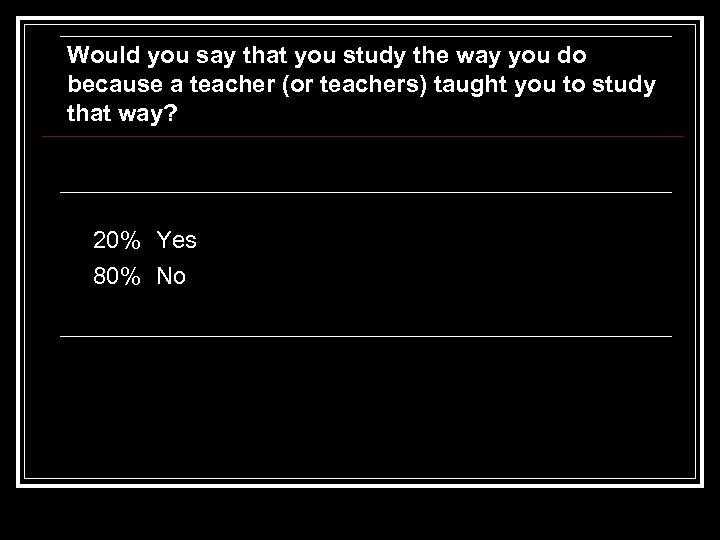 Would you say that you study the way you do because a teacher (or teachers) taught you to study that way? 20% Yes 80% No
Would you say that you study the way you do because a teacher (or teachers) taught you to study that way? 20% Yes 80% No
 Enhancing instruction n If students do not tend to engage in the learning activities that produce durable and flexible learning, n n n the fault is primarily ours; who among us, during our student days, would have answered those survey questions differently? We need to structure courses, curricula, requirements, and activities to engage the processes that enhance learning, comprehension, and knowledge integration n n Doing so requires, among other things, adopting the student’s perspective The subjective experience of students versus the subjective experience of teachers
Enhancing instruction n If students do not tend to engage in the learning activities that produce durable and flexible learning, n n n the fault is primarily ours; who among us, during our student days, would have answered those survey questions differently? We need to structure courses, curricula, requirements, and activities to engage the processes that enhance learning, comprehension, and knowledge integration n n Doing so requires, among other things, adopting the student’s perspective The subjective experience of students versus the subjective experience of teachers
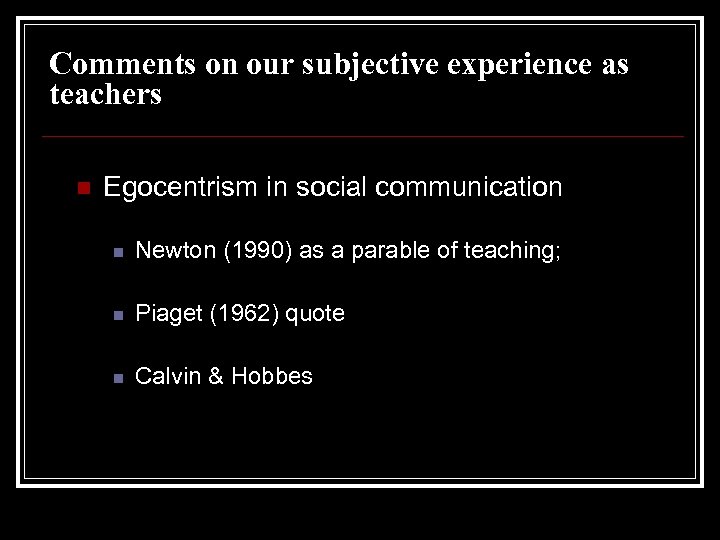 Comments on our subjective experience as teachers n Egocentrism in social communication n Newton (1990) as a parable of teaching; n Piaget (1962) quote n Calvin & Hobbes
Comments on our subjective experience as teachers n Egocentrism in social communication n Newton (1990) as a parable of teaching; n Piaget (1962) quote n Calvin & Hobbes
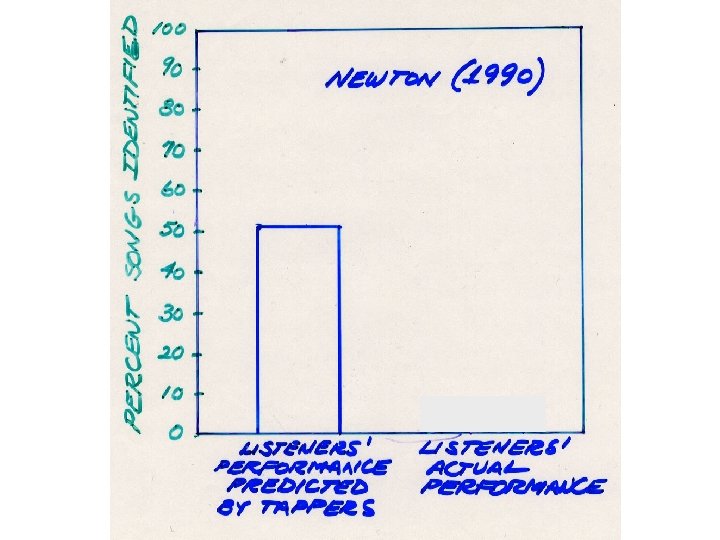
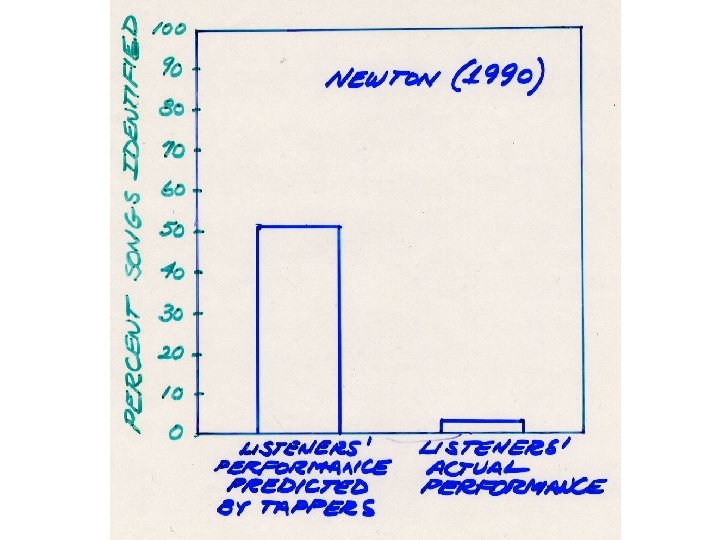
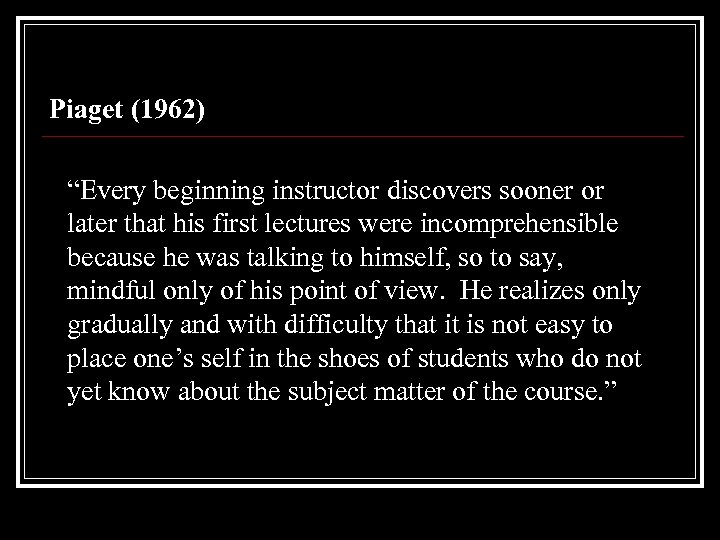 Piaget (1962) “Every beginning instructor discovers sooner or later that his first lectures were incomprehensible because he was talking to himself, so to say, mindful only of his point of view. He realizes only gradually and with difficulty that it is not easy to place one’s self in the shoes of students who do not yet know about the subject matter of the course. ”
Piaget (1962) “Every beginning instructor discovers sooner or later that his first lectures were incomprehensible because he was talking to himself, so to say, mindful only of his point of view. He realizes only gradually and with difficulty that it is not easy to place one’s self in the shoes of students who do not yet know about the subject matter of the course. ”

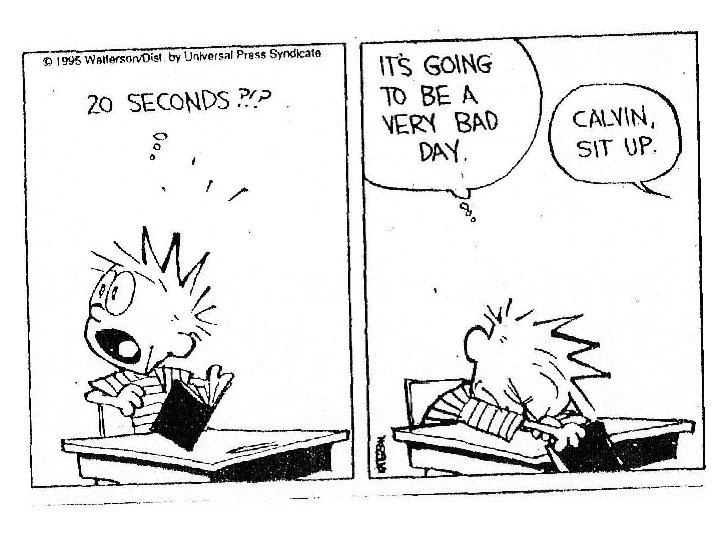
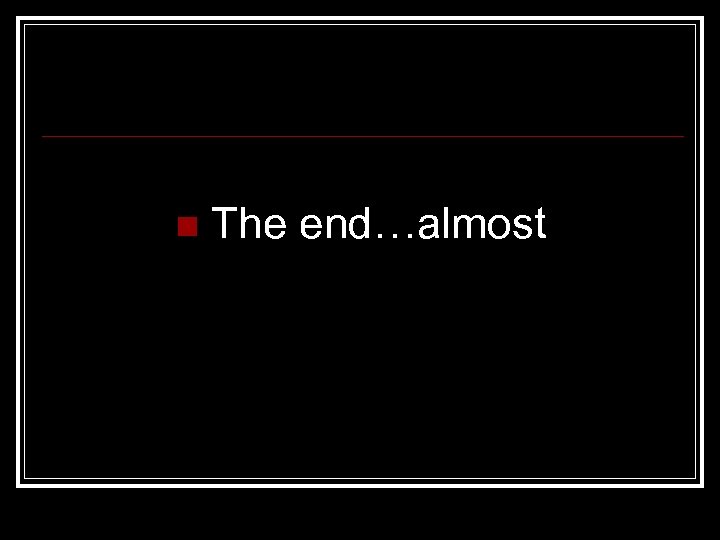 n The end…almost
n The end…almost
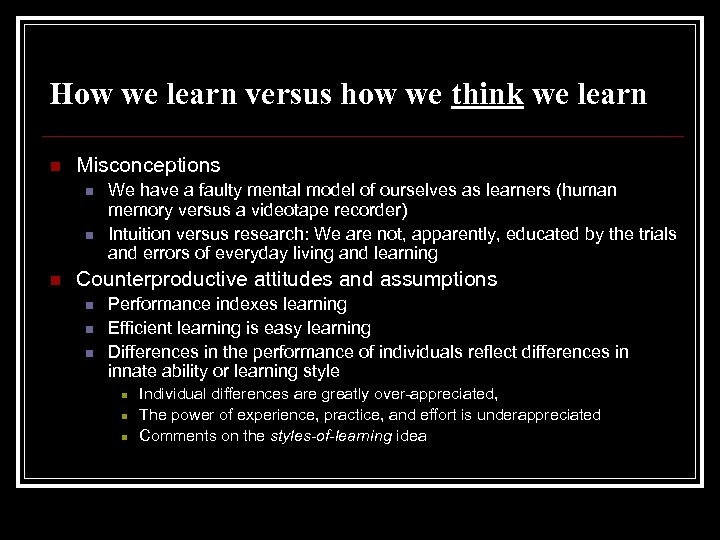 How we learn versus how we think we learn n Misconceptions n n n We have a faulty mental model of ourselves as learners (human memory versus a videotape recorder) Intuition versus research: We are not, apparently, educated by the trials and errors of everyday living and learning Counterproductive attitudes and assumptions n n n Performance indexes learning Efficient learning is easy learning Differences in the performance of individuals reflect differences in innate ability or learning style n n n Individual differences are greatly over-appreciated, The power of experience, practice, and effort is underappreciated Comments on the styles-of-learning idea
How we learn versus how we think we learn n Misconceptions n n n We have a faulty mental model of ourselves as learners (human memory versus a videotape recorder) Intuition versus research: We are not, apparently, educated by the trials and errors of everyday living and learning Counterproductive attitudes and assumptions n n n Performance indexes learning Efficient learning is easy learning Differences in the performance of individuals reflect differences in innate ability or learning style n n n Individual differences are greatly over-appreciated, The power of experience, practice, and effort is underappreciated Comments on the styles-of-learning idea
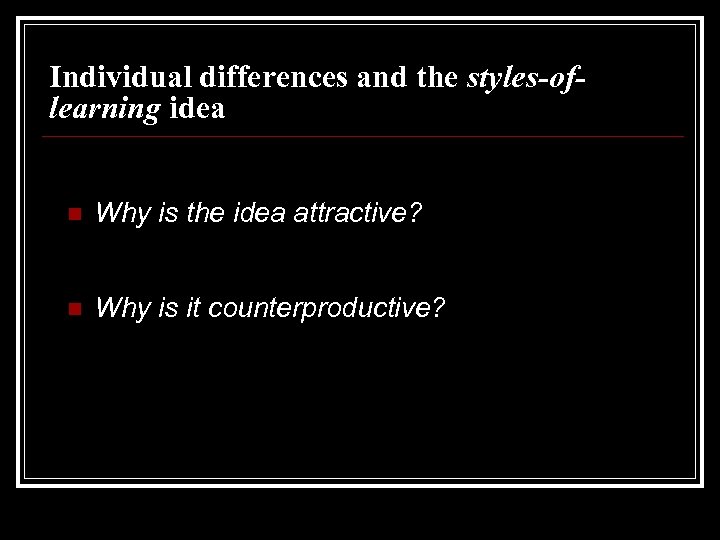 Individual differences and the styles-oflearning idea n Why is the idea attractive? n Why is it counterproductive?
Individual differences and the styles-oflearning idea n Why is the idea attractive? n Why is it counterproductive?
 Parents Of Nasal Learners Demand Odor-Based Curriculum March 15, 2000 | Issue 36 • 09 COLUMBUS, OH–Backed by olfactory-education experts, parents of nasal learners are demanding that U. S. public schools provide odor-based curricula for their academically struggling children. A nasal learner struggles with an odorless textbook. "Despite the proliferation of countless scholastic tests intended to identify children with special needs, the challenges facing nasal learners continue to be ignored, " said Delia Weber, president of Parents Of Nasal Learners, at the group's annual conference. "Every day, I witness firsthand my son Austin's struggle to succeed in a school environment that recognizes the needs of visual, auditory, tactile, and kinesthetic learners but not him. ” … "My child is not stupid, " Weber said. "There simply was no way for him to thrive in a school that only caters to traditional students who absorb educational concepts by hearing, reading, seeing, discussing, drawing, building, or acting out. "
Parents Of Nasal Learners Demand Odor-Based Curriculum March 15, 2000 | Issue 36 • 09 COLUMBUS, OH–Backed by olfactory-education experts, parents of nasal learners are demanding that U. S. public schools provide odor-based curricula for their academically struggling children. A nasal learner struggles with an odorless textbook. "Despite the proliferation of countless scholastic tests intended to identify children with special needs, the challenges facing nasal learners continue to be ignored, " said Delia Weber, president of Parents Of Nasal Learners, at the group's annual conference. "Every day, I witness firsthand my son Austin's struggle to succeed in a school environment that recognizes the needs of visual, auditory, tactile, and kinesthetic learners but not him. ” … "My child is not stupid, " Weber said. "There simply was no way for him to thrive in a school that only caters to traditional students who absorb educational concepts by hearing, reading, seeing, discussing, drawing, building, or acting out. "
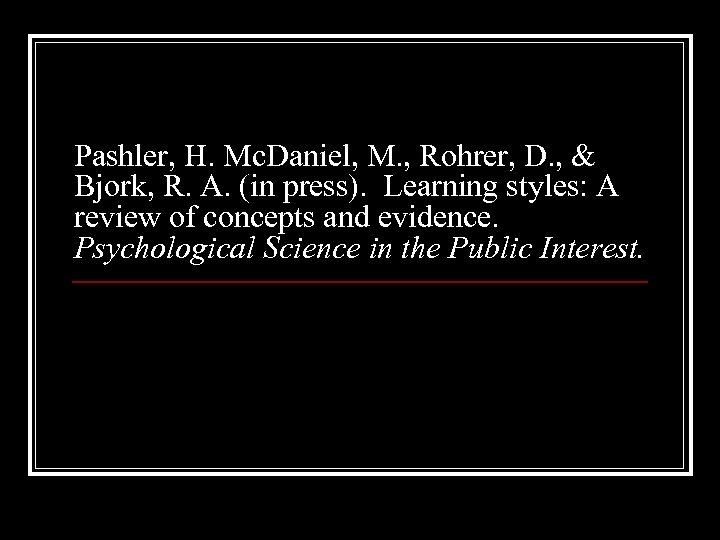 Pashler, H. Mc. Daniel, M. , Rohrer, D. , & Bjork, R. A. (in press). Learning styles: A review of concepts and evidence. Psychological Science in the Public Interest.
Pashler, H. Mc. Daniel, M. , Rohrer, D. , & Bjork, R. A. (in press). Learning styles: A review of concepts and evidence. Psychological Science in the Public Interest.
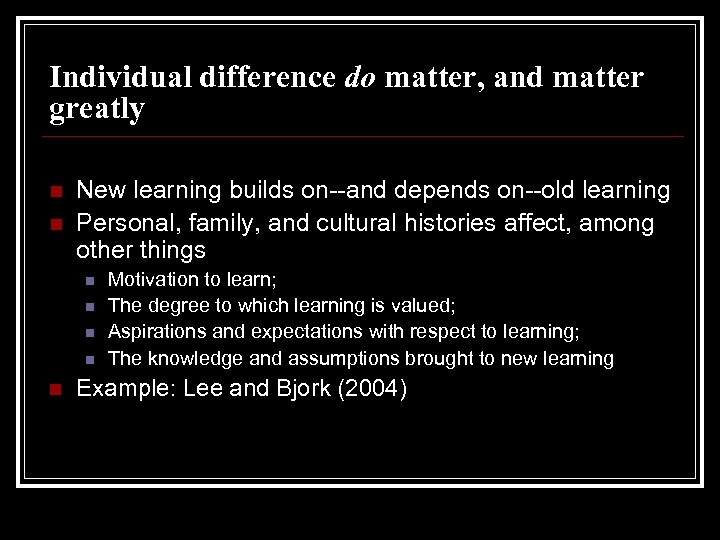 Individual difference do matter, and matter greatly n n New learning builds on--and depends on--old learning Personal, family, and cultural histories affect, among other things n n n Motivation to learn; The degree to which learning is valued; Aspirations and expectations with respect to learning; The knowledge and assumptions brought to new learning Example: Lee and Bjork (2004)
Individual difference do matter, and matter greatly n n New learning builds on--and depends on--old learning Personal, family, and cultural histories affect, among other things n n n Motivation to learn; The degree to which learning is valued; Aspirations and expectations with respect to learning; The knowledge and assumptions brought to new learning Example: Lee and Bjork (2004)
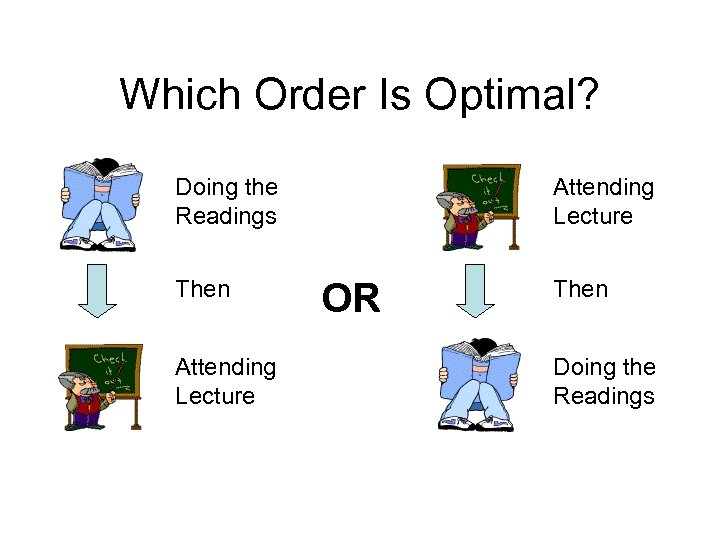 Which Order Is Optimal? Doing the Readings Attending Lecture Then Attending Lecture OR Doing the Readings
Which Order Is Optimal? Doing the Readings Attending Lecture Then Attending Lecture OR Doing the Readings
 What Do You Do? 34% 66% Which Is More Effective? 67% 33% Which Is More Difficult? 66% 34% Text then Lecture then Text
What Do You Do? 34% 66% Which Is More Effective? 67% 33% Which Is More Difficult? 66% 34% Text then Lecture then Text
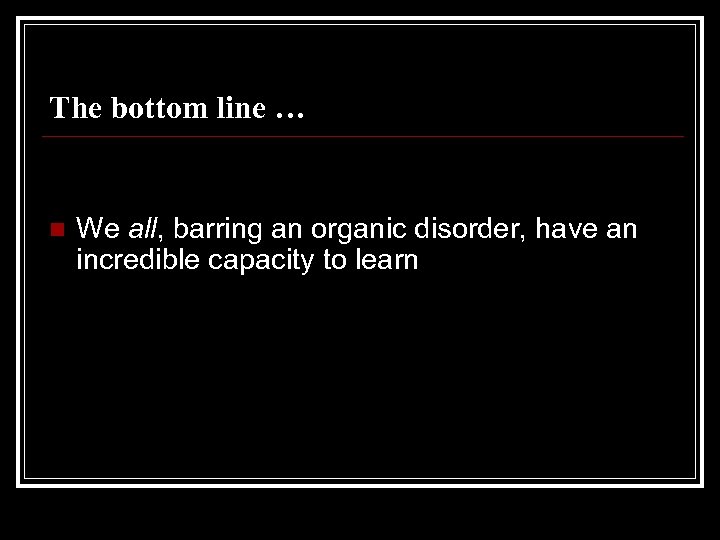 The bottom line … n We all, barring an organic disorder, have an incredible capacity to learn
The bottom line … n We all, barring an organic disorder, have an incredible capacity to learn
 n The actual end
n The actual end
 References n Baddeley, A. D. , & Longman, D. J. A. (1978). The influence of length and frequency of training session on the rate of learning to type. Ergonomics, 21, 627 -635. n Benjamin, A. S. , Bjork, R. A. , & Schwartz, B. L. (1998). The mismeasure of memory: When retrieval fluency is misleading as a metamnemonic index. Journal of Experimental Psychology: General, 127, 55 -68. n Bjork, R. A. (1994). Memory and metamemory considerations in the training of human beings. In J. Metcalfe and A. Shimamura (Eds. ), Metacognition: Knowing about knowing. (pp. 185 -205). Cambridge, MA: MIT Press. n Bjork, R. A. , & Bjork, E. L. (1992). A new theory of disuse and an old theory of stimulus fluctuation. In A. Healy, S. Kosslyn, & R. Shiffrin (Eds. ), From learning processes to cognitive processes: Essays in honor of William K. Estes (Vol. 2, pp. 35 -67). Hillsdale, NJ: Erlbaum. n Estes, W. K. (1955). Statistical theory of distributional phenomena in learning. Psychological Review, 62, 369 -377. n Hull, C. L. (1943). The principles of behavior. New York: Appleton-Century-Crofts. n Jacoby, L. L. , Bjork, R. A. , & Kelley, C. M. (1994). Illusions of comprehension, competence, and remembering. In D. Druckman and R. A. Bjork (Eds. ), Learning, remembering, believing: Enhancing human performance (pp. 57 -80). Washington, DC: National Academy Press. n Karpicke, J. D. , & Roediger, H. L. (2008). The critical importance of retrieval for learning. Science, 319, 966968. n Kerr, R. , & Booth, B. (1978). Specific and varied practice of a motor skill. Perceptual and Motor Skills, 46, 395 -401.
References n Baddeley, A. D. , & Longman, D. J. A. (1978). The influence of length and frequency of training session on the rate of learning to type. Ergonomics, 21, 627 -635. n Benjamin, A. S. , Bjork, R. A. , & Schwartz, B. L. (1998). The mismeasure of memory: When retrieval fluency is misleading as a metamnemonic index. Journal of Experimental Psychology: General, 127, 55 -68. n Bjork, R. A. (1994). Memory and metamemory considerations in the training of human beings. In J. Metcalfe and A. Shimamura (Eds. ), Metacognition: Knowing about knowing. (pp. 185 -205). Cambridge, MA: MIT Press. n Bjork, R. A. , & Bjork, E. L. (1992). A new theory of disuse and an old theory of stimulus fluctuation. In A. Healy, S. Kosslyn, & R. Shiffrin (Eds. ), From learning processes to cognitive processes: Essays in honor of William K. Estes (Vol. 2, pp. 35 -67). Hillsdale, NJ: Erlbaum. n Estes, W. K. (1955). Statistical theory of distributional phenomena in learning. Psychological Review, 62, 369 -377. n Hull, C. L. (1943). The principles of behavior. New York: Appleton-Century-Crofts. n Jacoby, L. L. , Bjork, R. A. , & Kelley, C. M. (1994). Illusions of comprehension, competence, and remembering. In D. Druckman and R. A. Bjork (Eds. ), Learning, remembering, believing: Enhancing human performance (pp. 57 -80). Washington, DC: National Academy Press. n Karpicke, J. D. , & Roediger, H. L. (2008). The critical importance of retrieval for learning. Science, 319, 966968. n Kerr, R. , & Booth, B. (1978). Specific and varied practice of a motor skill. Perceptual and Motor Skills, 46, 395 -401.
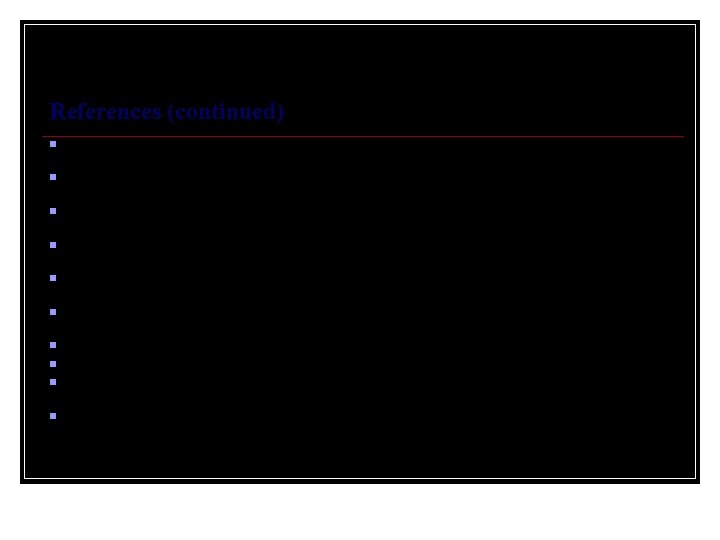 References (continued) n Kornell, N. , & Bjork, R. A. (2007). The promise and perils of self-regulated study. Psychonomic Bulletin & Review, 14, 219– 224. n Kornell, N. , & Bjork, R. A. (2008). Learning concepts and categories: Is spacing the "enemy of induction"? Psychological Science, 19, 585 -592. n Kornell, N. , Hays, M. J. , & Bjork, R. A. (2009). Unsuccessful retrieval attempts enhance subsequent learning. Journal of Experimental Psychology: Learning, Memory, & Cognition, 35(4), 2009, 989 -998. n Mannes S. M. , & Kintsch, W. (1987). Knowledge organization and text organization. Cognition and Instruction, 4, 91 -115. n Newton, L. (1990). Overconfidence in the Communication of Intent: Heard and Unheard Melodies. Unpublished doctoral dissertation, Department of Psychology, Stanford University. n Pashler, H. Mc. Daniel, M. , Rohrer, D. , & Bjork, R. A. (in press). Learning styles: A review of concepts and evidence. Psychological Science in the Public Interest. n Piaget, J. (1962). Play, Dreams and Imitation in Childhood. New York: Norton. n Reder, L. M. (1987). Selection strategies in question answering. Cognitive Psychology, 19, 90 -138. n Roediger, H. L. & Karpicke, J. D. (2006). Test-enhanced learning: Taking memory tests improves long-term retention. Psychological Science, 17, 249 -255. n Rohrer, D. , & Taylor, K. (2007). The shuffling of mathematics practice problems improves learning. Instructional Science, 35, 481 -498.
References (continued) n Kornell, N. , & Bjork, R. A. (2007). The promise and perils of self-regulated study. Psychonomic Bulletin & Review, 14, 219– 224. n Kornell, N. , & Bjork, R. A. (2008). Learning concepts and categories: Is spacing the "enemy of induction"? Psychological Science, 19, 585 -592. n Kornell, N. , Hays, M. J. , & Bjork, R. A. (2009). Unsuccessful retrieval attempts enhance subsequent learning. Journal of Experimental Psychology: Learning, Memory, & Cognition, 35(4), 2009, 989 -998. n Mannes S. M. , & Kintsch, W. (1987). Knowledge organization and text organization. Cognition and Instruction, 4, 91 -115. n Newton, L. (1990). Overconfidence in the Communication of Intent: Heard and Unheard Melodies. Unpublished doctoral dissertation, Department of Psychology, Stanford University. n Pashler, H. Mc. Daniel, M. , Rohrer, D. , & Bjork, R. A. (in press). Learning styles: A review of concepts and evidence. Psychological Science in the Public Interest. n Piaget, J. (1962). Play, Dreams and Imitation in Childhood. New York: Norton. n Reder, L. M. (1987). Selection strategies in question answering. Cognitive Psychology, 19, 90 -138. n Roediger, H. L. & Karpicke, J. D. (2006). Test-enhanced learning: Taking memory tests improves long-term retention. Psychological Science, 17, 249 -255. n Rohrer, D. , & Taylor, K. (2007). The shuffling of mathematics practice problems improves learning. Instructional Science, 35, 481 -498.
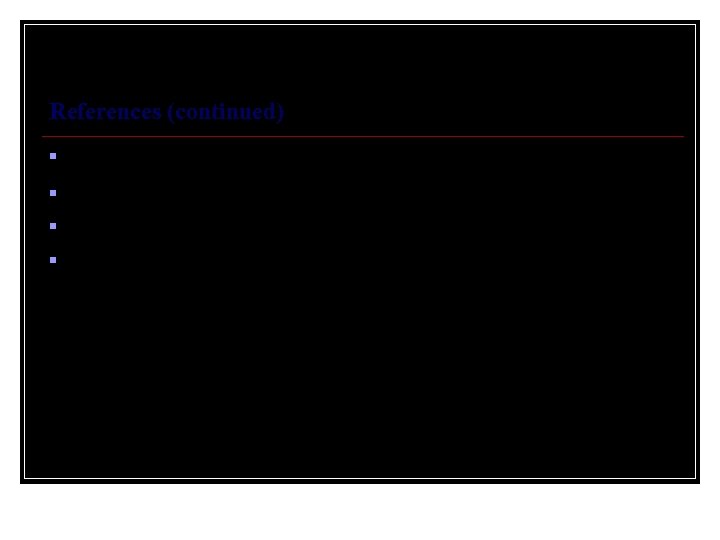 References (continued) n Simon, D. A. , & Bjork, R. A. (2001). Metacognition in motor learning. Journal of Experimental Psychology: Learning, Memory, and Cognition, 27, 907 -912. n Smith, S. M, Glenberg, A. M. , & Bjork, R. A. (1978). Environmental context and human memory. Memory & Cognition, 6, 342 -353. n Smith, M. K. , Wood, W. B. , Adams, W. K. , Wieman, C. , Knight, J. K. , Guild, N. , & Su, T. T. (2009). Why peer discussion improves student performance on in-class concept questions. Science, 323, 122 -124. n Ste-Marie, D. M. , Clark, S. E. , Findlay, L. C. & Latimer A. E. (2004). High levels of contextual interference enhance handwriting skill acquisition. Journal of Motor Behavior, 36, 115 -126.
References (continued) n Simon, D. A. , & Bjork, R. A. (2001). Metacognition in motor learning. Journal of Experimental Psychology: Learning, Memory, and Cognition, 27, 907 -912. n Smith, S. M, Glenberg, A. M. , & Bjork, R. A. (1978). Environmental context and human memory. Memory & Cognition, 6, 342 -353. n Smith, M. K. , Wood, W. B. , Adams, W. K. , Wieman, C. , Knight, J. K. , Guild, N. , & Su, T. T. (2009). Why peer discussion improves student performance on in-class concept questions. Science, 323, 122 -124. n Ste-Marie, D. M. , Clark, S. E. , Findlay, L. C. & Latimer A. E. (2004). High levels of contextual interference enhance handwriting skill acquisition. Journal of Motor Behavior, 36, 115 -126.


